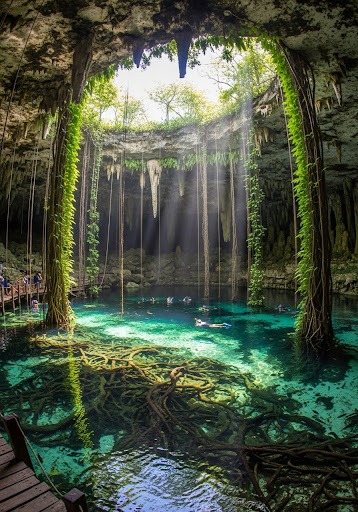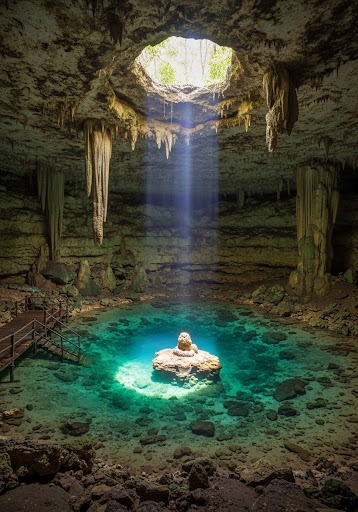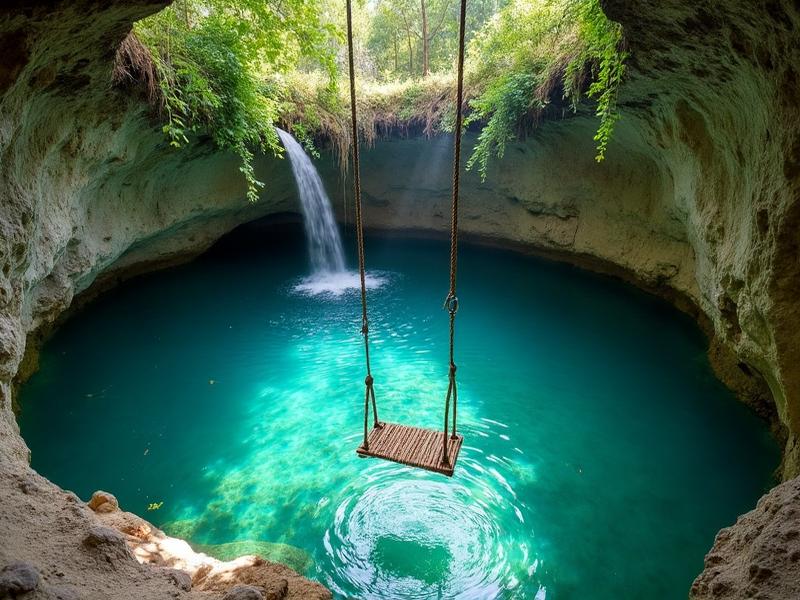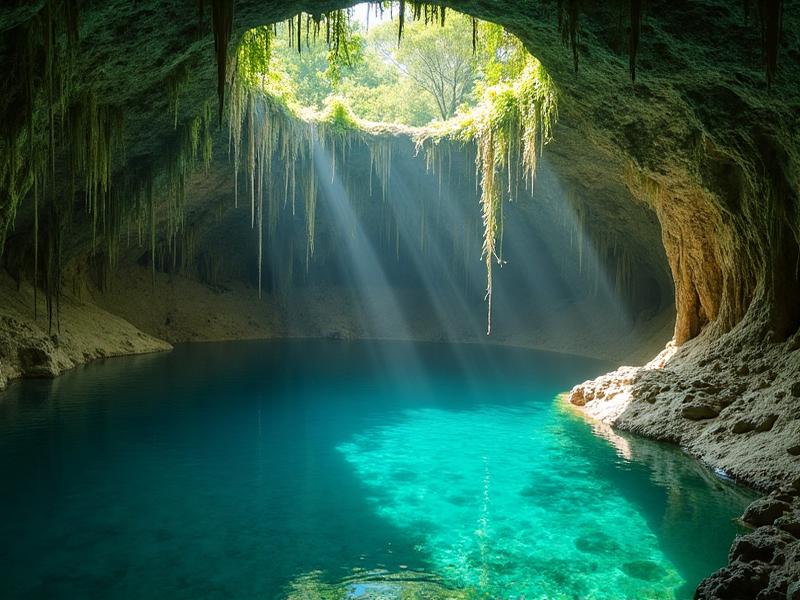Top 10 Best Cenotes to Visit in the Yucatan Peninsula

From famous swimming locations in Tulum to quiet spots off the main road, here are our favorite cenotes for your Mexico trip.
Top 10 Best Cenotes to Visit in the Yucatan Peninsula
From famous swimming locations in Tulum to quiet spots off the main road, here are our favorite cenotes for your Mexico trip.
Gran Cenote (Grand Cenote)
One of the most visited cenotes near Tulum, Grand Cenote is excellent for swimming and snorkeling. The clear water reveals striking rock formations and linked underground systems. This organized site features wooden platforms for easy entry and is a must-see for anyone staying in Tulum. Its location makes it simple to get to from the main road. The layout, a large circular opening leading to a cavern, allows for plenty of light.
Highlights:
Local Tip: Visit right at 8:00 AM to avoid the tour buses. Bring biodegradable sunscreen only. They may charge extra for "professional" cameras (DSLRs).

Cenote Dos Ojos
Famous for cavern diving, Cenote Dos Ojos ("Two Eyes") is part of Sistema Sac Actun, one of the world's longest underwater systems. The two "eyes" are the main entry points, one clear and blue (the "Barbie Line") for snorkelers, and the other darker (the "Bat Cave Line") for divers. The striking blue water and impressive stalactite structures make this a favorite for experienced divers and snorkelers alike. The system is a geological marvel.
Highlights:
Local Tip: Book a private guided tour for snorkeling or diving to fully appreciate the underwater passages. Read reviews before visiting to choose the best tour option.

Cenote Calavera (Skull Cenote)
Cenote Calavera, meaning 'Skull Cenote', is a unique sinkhole near Tulum. Ideal for jumping and rope swings, this small cenote offers a fun outing. The three holes in the ceiling (one large, two small) look like a skull when viewed from above. Less crowded than other Tulum sites, it's great for photos and enjoying a bit of adrenaline. If you like to jump into freshwater, this is your spot. The location is easy to find, right off the road to Coba.
Highlights:
Local Tip: Bring cash for entrance. Arrive early for the best light. The jump is higher than it looks, so be sure you're comfortable with it.

Casa Cenote (Cenote Manatí)
Casa Cenote offers a different setting with its winding mangrove channel and connection to the Caribbean Sea. The freshwater meets the sea, creating a unique lagoon. This is one of the most interesting and quiet cenotes for kayaking, snorkeling, and discovering fish. The mangrove roots create a nursery for many reef fish. The water is exceptionally clear, and you might even spot a small crocodile named 'Panchito' who lives there (he's used to people).
Highlights:
Local Tip: Rent a car to explore nearby sites and beaches. We recommend this cenote for a relaxing day. It's also a popular spot for beginner scuba dives.

Cenote Jaguar
Located along the 'Ruta de los Cenotes' near Puerto Morelos, Cenote Jaguar is a lovely spot surrounded by dense trees. This site offers a peaceful swim away from crowded destinations. The clear blue water makes it worth the trip. The cenote is an open-style hole with stone features around the edge, and often includes zip-lines and platforms for jumping. It's part of a larger park that sometimes offers other activities.
Highlights:
Local Tip: Combine with other cenotes on the route for a full day. Renting a car is recommended for exploring this area. Look at a map before you go, as signage can be minimal.

Cenote Suytun
Famous for its dramatic light beam at noon, Cenote Suytun features a stone platform in the center of its water. This underground cenote near Valladolid is magical when the sun creates a spotlight through the ceiling opening. The beam hits the water, creating a popular photo opportunity. You have to walk down a stone staircase to enter this site. The cavern itself is vast, with many stalactites.
Highlights:
Local Tip: Visit around 11 AM to 1 PM for the famous light beam, but be aware this is also the most crowded time. Arrive early if you want photos without many people.

Cenote Sac Actun
Part of the Sistema Sac Actun, one of the world's longest underwater systems. This site is a dream destination for scuba enthusiasts and serious divers. The underground exploration reveals huge stalagmites and stalactites that took millions of years to form. This is not a casual swimming spot; it's a guided snorkeling or diving tour through a mostly submerged cavern system, often in a wetsuit due to the cooler water.
Highlights:
Local Tip: Book with an experienced and recommended guide. Safety gear and proper training are essential. This is not an option for casual swimmers; you need certification for diving. Snorkeling tours are available.

Cenote Azul & Cenote Cristalino
Two pleasant cenotes close to each other, great for a day trip from Playa del Carmen or Cancun. Cenote Azul is a large, open cenote with multiple pools of varying depths, making it great for families. It offers wooden platforms for those who like to jump. Cenote Cristalino is similar, a long, open 'river-like' cenote ideal for relaxing, swimming, and enjoying the clear blue water. These are popular with locals on weekends.
Highlights:
Local Tip: We recommend bringing your own water and food to save money. The entrance includes basic facilities. Visit during the week when it's less crowded.

Cenote Del Eden (Ponderosa)
Cenote Del Eden, also known as Ponderosa, is one of the most popular open cenotes on the 'Ruta de los Cenotes'. This huge lagoon-style cenote is surrounded by greenery and offers a paradise for swimming, snorkeling, and relaxing. The cenote has a large water area with both shallow entry points and deeper sections. Wooden platforms provide entry, and there are jumping platforms. The water is very clear, and you can see fish swimming.
Highlights:
Local Tip: Cenote Del Eden is worth a visit if you're on the 'Ruta de los Cenotes'. You can easily spend a couple of hours here. Combine it with nearby cenotes for a full day.

More Stunning Cenotes Worth the Trip

Cenote Ik Kil
Located very close to Chichen Itza, this is perhaps one of the most photographed cenotes in the Yucatan. It's a deep, perfectly circular open cenote with long vines and small waterfalls cascading down to the water. A grand, carved stone staircase winds down to the swimming platform. It's an organized site, meaning it has lockers, changing rooms, and a restaurant.

Cenotes near Valladolid
The colonial town of Valladolid is a fantastic hub. Cenote Zaci is located inside the town, just a few blocks from the main square. Cenote X'keken (Dzitnup) and Cenote Samulá are located at the same site just outside of town. Both are underground caverns, with X'keken famous for its narrow opening and stalactites, while Samulá is a larger cavern with a single, dramatic hole in the ceiling where tree roots hang down.

Cenote Chaak Tun
An underground cenote with private guided tours. This is less of a swimming hole and more of an excursion. You'll walk through passages on wooden platforms and swim in hidden chambers filled with clear water, guided by helmet and headlamp. The tour takes about an hour and is great for learning about the geology.

Cenotes near Coba Ruins
Located near the Coba ruins, these cenotes offer a relaxing stop after climbing the Mayan pyramid. Cenote Choo-Ha, Tamcach-Ha, and Multum-Ha are all nearby. Choo-Ha is a shallow, fully underground cavern with many stalactites. Tamcach-Ha is much deeper and features two high jumping platforms (5 and 10 meters) for thrill-seekers.

Cenote Atik
Cenote Atik offers a more secluded feel. This freshwater cenote is surrounded by trees and is good for people looking for a quiet spot away from crowds. The wooden platform provides entry, and the lagoon-style setting is ideal for swimming. It's known for its photogenic, rustic look.
Types of Cenotes: Understanding These Natural Wonders
Cenotes are geological sinkholes formed over millions of years. The Yucatan Peninsula is essentially a massive, flat platform made of porous limestone. Over time, acidic rainwater (rain mixing with CO2) dissolved this limestone, carving out vast underground river systems. When the roof of one of these underground caverns became too thin, it would collapse, creating a cenote. The 'type' of cenote (Open, Semi-Open, Cave) simply represents its age.
Cave Cenotes (Youngest)
Almost entirely enclosed, with only a small opening in the roof. The water is often very still, filled with stalactites and stalagmites (e.g., Cenote Suytun).
Semi-Open Cenotes (Middle-Aged)
Partial roof collapse, allowing significant light and air to enter. They offer a balance between a cave atmosphere and openness (e.g., Gran Cenote).
Open Cenotes (Oldest)
The entire roof has eroded away, leaving what looks like a natural, tree-lined lake or lagoon (e.g., Cenote Azul).
Activities at Cenotes: More Than Just Swimming
Cenotes offer incredible options for activity and relaxation. Here's what you can enjoy:
Swimming & Floating
The clear freshwater is great for swimming. The water temperature is cool and refreshing—around 24-25°C (75-77°F) year-round. Many cenotes have both shallow areas for easy entry and deep sections.
Snorkeling
The clear water offers amazing visibility for snorkeling. The clarity is often staggering, allowing you to see 50 meters or more. Look for the small black catfish that often inhabit these waters, as well as various other small fish and sometimes turtles.
Cliff Jumping & Rope Swings
For thrill-seekers! Cenote Calavera, Cenote Azul, and Cenote Tamcach-Ha have wooden or stone platforms for jumping. Some have rope swings. Always check the water depth before jumping and land in the designated deep area.
Cave Diving & Scuba
For experienced divers, scuba in cenotes is a bucket-list item. You must have proper certification and go with a certified guide. The cavern zone offers views of haloclines where freshwater and saltwater meet.
Kayaking
Some cenotes like Casa Cenote and other large, open lagoons offer kayak rentals. Paddle through the water, explore mangroves, and enjoy the quiet surroundings.
Photography
Cenotes are very photogenic. For the best shots, an underwater camera (like a GoPro) is essential. Note that some sites may charge an extra fee for professional cameras.
Hiking & Walking
Many cenotes are set within larger parks or jungle paths. The Ruta de los Cenotes near Puerto Morelos offers opportunities to walk or bike between cenotes.
Picnicking & Relaxing
Some cenotes (mostly open-style ones) have areas for picnicking and relaxing by the water. Bring food and drinks, though many have restaurants on-site.
Cenote Routes & Road Trip Planning
Create a great cenote road trip by following these popular routes:
Tulum Cenote Route
Start from Tulum and explore cenotes within a short trip. Visit Gran Cenote (5 mins), Cenote Calavera (10 mins), Dos Ojos (15 mins), and Casa Cenote (20 mins).
Ruta de los Cenotes (Puerto Morelos)
The famous cenote route! This road stretches west from Puerto Morelos inland through the jungle, passing dozens of cenotes.
Valladolid Cenote Circuit
Base yourself in the colonial town of Valladolid. Visit Cenote Suytun (15 mins), Cenote X'keken and Samulá (20 mins), and Cenote Zaci in town. Then drive to Chichen Itza (45 mins) and swim in Cenote Ik Kil.
Playa del Carmen to Tulum Route
Drive from Playa del Carmen to Tulum, stopping at cenotes along the way. Visit Cenote Azul and Cristalino (30 mins from Playa), Cenote Chaak Tun (20 mins), then continue to Tulum's cenotes.
Bacalar Lagoon & Cenotes
Visit the stunning Laguna Bacalar and explore nearby cenotes. Cenote Azul Bacalar is a huge, deep, open cenote right near the lagoon. The combination of the lagoon and cenotes makes this a unique trip several hours south of Tulum.
Essential Tips for Your Cenote Visit
- Best Time to Visit: Go early in the morning (8-9 AM) when tour buses haven't arrived. Weekdays are less crowded than weekends.
- Bring Cash (Pesos): Most cenotes do not accept credit cards. The entrance fee is cash only, and so are rentals and most on-site food.
- Biodegradable Sunscreen: This is mandatory at most cenotes. Regular sunscreen contains oils that damage the delicate ecosystem and stone formations.
- Water Shoes: These are very helpful! The ground around cenotes can have sharp rocks, and the wooden platforms or stone stairs can be slippery.
- Snorkel Gear: Bring your own to save money on rentals.
- Towel & Dry Clothes: A quick-dry towel is ideal.
- Waterproof Camera: A waterproof phone case or camera is great for capturing underwater shots.
- Water and Food: While many sites have restaurants, bringing your own water and snacks is a good idea, especially for more remote locations.
- Mosquitoes: In jungle-heavy areas, bring biodegradable insect repellent.
- Drones: Most popular cenotes strictly prohibit flying drones.
- Swimming Ability: Choose cenotes based on your comfort. Rent a life jacket if you're not a strong swimmer.
- Jumping Safety: Always check the water depth before jumping from platforms or cliffs. Never dive head-first.
- Guided Tours: For underground cenotes and scuba diving, always use a guided tour with experienced instructors.
- Respect the Ecosystem: Do not touch the stalactites or stalagmites; the oils from your skin can stop their growth.
- Respect the Culture: Many of these sites are important to Mayan culture. Keep voices low, don't litter, and treat these sites with respect.
- Entrance Fees: Expect 100-200 pesos for smaller spots and 300-500+ pesos for popular ones. Premium tours (like Sac Actun) can cost 1,200 pesos or more.
- Rentals & Food Costs: Snorkel rentals are typically 100-150 pesos, lockers 50-100 pesos, and on-site meals 150-300 pesos.
Cenote Travel FAQ: Your Questions Answered
Start Your Cenote Trip in Mexico
Ready to discover the wonders of cenotes in the Yucatan Peninsula? From cavern snorkeling to relaxing swims, your trip awaits. Book your flight and rent a car to explore these natural pools at your own pace.